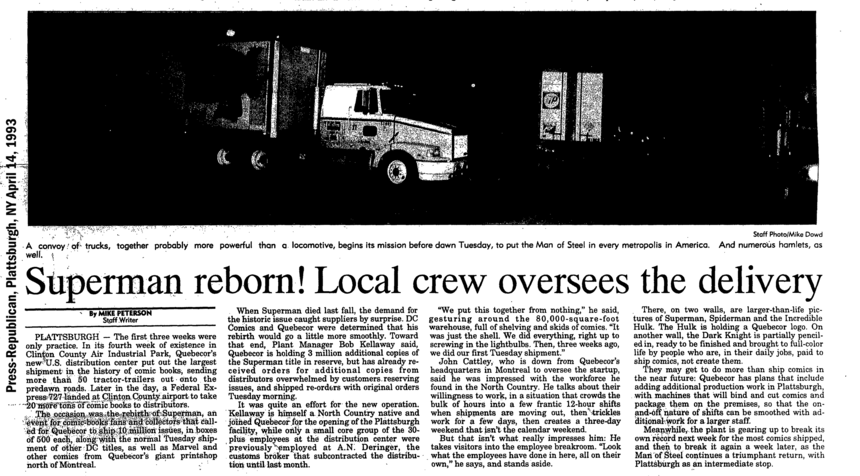Comic Strip of the Day: Collectible Consciousness
Skip to comments Bado has coverage on his blog of an interesting auction, in which the only known copy, outside the Library of Congress, of the newspaper in which Ben Franklin’s original “Join, or Die” cartoon appeared was auctioned off for the minimum bid of $40,000, which went to $50,000 with the buyer’s premium.
Bado has coverage on his blog of an interesting auction, in which the only known copy, outside the Library of Congress, of the newspaper in which Ben Franklin’s original “Join, or Die” cartoon appeared was auctioned off for the minimum bid of $40,000, which went to $50,000 with the buyer’s premium.
“Interesting,” in part because he includes the auction house’s extensive description, which puts the cartoon in a time and context I hadn’t known: It was before the French and Indian War, and only later re-purposed during the Revolution.
 On the one hand, of course people have always scrounged and kept things they liked, but it strikes me as beyond “unusual” that anybody managed to hold on to a newspaper from 1754, even if they discarded the pages of ads that had run in that issue.
On the one hand, of course people have always scrounged and kept things they liked, but it strikes me as beyond “unusual” that anybody managed to hold on to a newspaper from 1754, even if they discarded the pages of ads that had run in that issue.
Now, Franklin was likely printing on a paper with a high rag content, which would make it more durable than one printed on pulp. Book collectors know that a book from 1850 is likely to be in better shape than one from 1900 because of recent changes in papermaking.
Still, you have to wonder at the perseverence of interest that kept somebody at some point in the intervening 264 years from saying, “Grandpa sure saved a lot of crap” and throwing it out.
However, I also wonder that it went so cheap, and, no, I don’t think it’s because the ad pages were tossed out, though that might have boosted the interest a bit.
But some things are collectible and some things aren’t, and it has more to do with the tastes and interests of the crowd than the historical or other value of the piece itself.
So a first edition of one of the most significant political cartoons in our history goes for forty grand, while the jacket Harrison Ford wore as Han Solo is expected to go for $1.3 million, and, while I’m kind of appalled, I’m not particularly shocked or surprised.
But I think the person who bought that old newspaper got one helluva bargain and if anyone bids $1.3 million for that jacket, he’s a damned fool.
Again, though, not particularly shocked or surprised.
Hell, it’s not even the real Harrison Ford.
Anyway, I ran into this phenomenon during my year of unemployment back in 2009, when I began Ebaying off my extensive collection of the works of Victorian boys’ novelist G.A. Henty.
I had begun buying his books because I like historical fiction and his background as a war correspondent made his stories more realistic and better researched than others in the genre, though it’s appalling that his casual British Imperialistic racism — unsurprising in its time — makes him a favorite author today for teaching history among right-wing homeschoolers.
Other books — including a first edition of Anatole France — went begging on Ebay, but the Hentys were hot, and when I put up an odd title in an edition published in India for British readers stationed there, I had excited inquiries asking about the color of the end papers and whether the cover had a beveled edge and so forth.
In the end, that particular volume went for four figures, enough to recover the acquisition price of my entire collection, which was silly but which I certainly didn’t question at the time, being, as I said, out of work. It meant any money I received for the other books was pure gravy.
However, the apparently collectible can become worthless simply because their collectibility is obvious at the time. I put aside a set of “Empire Strikes Back” drinking glasses for my boys, but so did everyone else, so they’ve got them as keepsakes but not anything of any particular value.
 Which brings us to the life and death of Superman, and the current marketing of such, as covered by Todd Allen at the Beat, who writes with admirably cynical detachment:
Which brings us to the life and death of Superman, and the current marketing of such, as covered by Todd Allen at the Beat, who writes with admirably cynical detachment:
There’s a “Death of Superman” digital sale going on. It’s an odd thing that doesn’t seem to be totally Death of Superman related, but I suppose they’re trying to tie it into the current Death of Superman comic. You can’t kill a character off too many times, apparently.
In one of my last stories as a reporter, I was at the warehouse in April, 1993, when the first resurrection of dead Superman was launched, and, let me tell you, it was quite an event.
Everything was bundled up and we were checked in as if we were entering a missile site. Once inside, the photographer and I wandered around and came across a palette which had been slightly opened, such that the cover of the upcoming issue was exposed.
He began to take a photo at which point Tommy Lee Jones and Will Smith swept in and held their little flashlight thingies up to our eyes, or nearly so: A pair of suits suddenly wanted to know who we were, what we wanted and why we were trying to photograph the cover of the special magical very collectible sure-to-put-your-grandchildren-through-college issue.
Convinced that our newspaper — in those semi-pre-Internet days — was not going to be able to publish the pic until after the comic was on the newstand, they backed off, but the bottom line is that everyone bought two copies, one to read and one to stick in an envelope and never ever touch.
The net result being that most of this junk ends up being worth more or less what you paid for it, only not adjusted for inflation or for the hassle of storing it.
Anyway, as I’ve often said before, I feel Superman should have been encased, not in Tyvek envelopes, but in a conceptual setting appropriate for his original 10-year-old fans, as a way for kids to encounter superheroes that they will outgrow.
At which point you can sell them more complex comics about more complex characters.
For my part, I went from Superman to Spiderman and thence to a point where Superman and Green Lantern had nothin’ on me or on Fritz or Mr. Natural.
“Preserve your memories” being metaphorical advice, not a marketing plan.




Comments 2
Comments are closed.